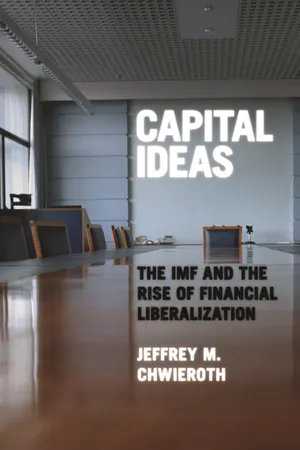
- 352 pages
- English
- PDF
- Available on iOS & Android
About this book
The right of governments to employ capital controls has always been the official orthodoxy of the International Monetary Fund, and the organization's formal rules providing this right have not changed significantly since the IMF was founded in 1945. But informally, among the staff inside the IMF, these controls became heresy in the 1980s and 1990s, prompting critics to accuse the IMF of indiscriminately encouraging the liberalization of controls and precipitating a wave of financial crises in emerging markets in the late 1990s. In Capital Ideas, Jeffrey Chwieroth explores the inner workings of the IMF to understand how its staff's thinking about capital controls changed so radically. In doing so, he also provides an important case study of how international organizations work and evolve.
Drawing on original survey and archival research, extensive interviews, and scholarship from economics, politics, and sociology, Chwieroth traces the evolution of the IMF's approach to capital controls from the 1940s through spring 2009 and the first stages of the subprime credit crisis. He shows that IMF staff vigorously debated the legitimacy of capital controls and that these internal debates eventually changed the organization's behavior--despite the lack of major rule changes. He also shows that the IMF exercised a significant amount of autonomy despite the influence of member states. Normative and behavioral changes in international organizations, Chwieroth concludes, are driven not just by new rules but also by the evolving makeup, beliefs, debates, and strategic agency of their staffs.
Frequently asked questions
- Essential is ideal for learners and professionals who enjoy exploring a wide range of subjects. Access the Essential Library with 800,000+ trusted titles and best-sellers across business, personal growth, and the humanities. Includes unlimited reading time and Standard Read Aloud voice.
- Complete: Perfect for advanced learners and researchers needing full, unrestricted access. Unlock 1.4M+ books across hundreds of subjects, including academic and specialized titles. The Complete Plan also includes advanced features like Premium Read Aloud and Research Assistant.
Please note we cannot support devices running on iOS 13 and Android 7 or earlier. Learn more about using the app.
Information
Table of contents
- Cover
- Contents
- List of Figures and Tables
- Preface
- List of Abbreviations
- CHAPTER ONE: Introduction
- CHAPTER TWO: Normative Change from Within
- CHAPTER THREE: Capital Ideas and Capital Controls
- CHAPTER FOUR: Capital Controlled: The Early Postwar Era
- CHAPTER FIVE: The Limits and Hollowness of Keynesianism in the 1960s
- CHAPTER SIX: Formal Change and Informal Continuity: The Reform Negotiations of the 1970s
- CHAPTER SEVEN: Capital Freed: Informal Change from the 1980s to the Mid-1990s
- CHAPTER EIGHT: Capital in Crisis: Financial Turmoil in the Late 1990s
- CHAPTER NINE: Norm Continuity and Organizational Legitimacy from the Asian Crisis to the Subprime Crisis
- EPILOGUE: A Subprime “Crisis” for Capital Freedom?
- Index